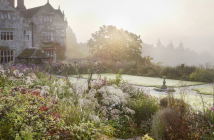Londoners take it for granted, visitors often miss the opportunity its views afford; but it’s been witness to more milestones in the city’s history than there are boats that follow its course. Margaret May takes a ride down Old Father Thames…
Where to look as I depart from Westminster Bridge on one of the many boats that service the River Thames? I have opted to travel downstream towards Greenwich – a journey, of some four and a half miles, which will pass through many of London’s most historical sites. Westminster Bridge will always remind me of Wordsworth’s opening line, “Earth has not anything to show more fair.” How he evoked the spirit of London’s majesty so long ago, and now I will pass the “ships, towers, domes, theatres and temples” of which he spoke. It seems an apt beginning to my journey indeed.
To my left – on the northern side of the river – government buildings are most in prominence and the old headquarters of Scotland Yard. Lawns and gardens attempt to secrete the Ministry of Defence and, then, the Banqueting House – used for all sorts of state occasions – the annual dinner for the Knights of the Garter on St. George’s Day and the ritual washing of commoners feet on Maundy Thursday by the monarch (Really? Perhaps once). Charles I was executed here in 1649 on a scaffold especially set up by the windows so that diners could watch the gruesome spectacle without having to move.

Cleopatra’s needle being transported from Alexandria, Egypt
Moving on I note the Cleopatra’s Needle – a 60 foot high granite monument which is guarded by two bronze sphinxes. Somewhat misleadingly the obelisk has nothing to do with Cleopatra but dates from the reign of the Pharaoh Tethmosis III and was presented to Britain by the Turkish Viceroy of Egypt. Originally one of a pair, that were carved in 1500 BC at Heliopolis in Egypt, the monument’s journey to London endured several adventures en route – variously lost, burned, broken, lost and found at sea – before finally being erected here on the Embankment in 1878. My curiosity finds that its twin finally reached its destination in Central Park, New York after a journey of 112 days from the Hudson River. Quite fascinating to find that the New York obelisk has a time-capsule buried beneath it and contains, among other things, the Bible, the complete works of Shakespeare and a copy of the Declaration of Independence. I can only hope that something similar lies under our obelisk here in London. We shall never know, presumably.
Onwards, and under Waterloo Bridge to pass the Courtauld Institute Galleries which contain a vast collection of Post-Impressionist paintings bequeathed to the nation by Samuel Courtauld – one of the many French Huguenots that fled here in the late 1600s.
And now to the tranquility and beauty of Temple – the defining boundary between the ancient City of London and the City of Westminster. Temple is historically famed for its courts and law schools which have existed here since the Middle Ages. Originally the schools were called Inns and had developed when a need to teach law – not then a university discipline – was recognised . Studies were concentrated in these wonderfully walled areas – students and faculty members were all fed and lodged here in an effort to minimise contact with the outside world and to better concentrate the mind. I find that of the ten Inns that existed in the 14th century only four now remain – Lincoln’s Inn, Middle and Inner Temples and Gray’s Inn. Today each Inn still has its own hall, library, church, cloister and gardens. Temple Bar – the boundary line – is known for its Felons Gate where, until 1772, the heads of executed criminals were exhibited as a reminder of the consequences of acting outside the law.
Ahead looms the magnificent dome of St. Paul’s Cathedral – only exceeded in size by that of St. Peter’s in Rome. 107 feet in diameter and 365 feet tall. A wonderfully imposing site that can only inspire one with a sense of London.

Claude de Jong, ‘View of Old London Bridge’ (1630), detail.
Passing under Southwark Bridge and onwards towards the bland and disappointing structure that is London Bridge is a horrible shock to the system. A mass of concrete that does such a disservice to its , supposedly, prominent name. This is a shame as the original bridge – so hauntingly depicted in the painting by Claude de Jongh in 1630 ( now to be seen in Kenwood House ) was so full of character and atmosphere. First established in 1209, people lived on the bridge – the only span across the Thames at the time – in a clutterance of narrow overhanging houses and shops. Many met a watery death, staggering home from the local ale houses , in the murky depths of the Thames. George Rennie’s 1820 replacement London Bridge was sold to the United States in in the early 1970s and now, somewhat incongruously, crosses Lake Havasu in Arizona. Today’s replacement, here in London, is, to me, completely devoid of beauty, character, history and imagination. The sense of disappointment and lost opportunity is overwhelming.
Thank goodness for the sight of Tower Bridge ahead. A far more symbolic structure to Londoners and tourists alike its twin towers give the appearance of Scottish castles in Gothic profile and the knowledge that a hydraulic lifting system enables its opening to allow the safe passage of ships lends it a romance all of its own. Today the hydraulics have been replaced with electric motors and it is a wonderful sight to see the bridge raised to facilitate shipping passage – which has priority over road and pedestrian traffic. Obviously, careful synchronisation is needed here – apparently a London bus driver once jumped the lights as the bridge began to rise and was trapped on the opening bascules!

Past the adjoining Tower of London – the bridge here imaginatively designed to match the stonework of the Tower and really providing a focal point of London’s past both historically and architecturally. The Tower is a dominant feature in this south-eastern corner of the City of London. I have no time to ruminate though as we sail past Docklands – once a bustling area of wharves and warehouses but, today after many years of neglect and decay, a redeveloped, expensive and chic place to live.
And now here is Greenwich as the boat heads towards the South Bank – best known for its Zero Meridian from which longitude and world standard time are measured. GMT – Greenwich Mean Time. This is a delightfully green and spacious area of the city, packed full of wonderful architecture and its strong connections to the sea, science, sovereigns and time and beautifully laid out through its museums and monuments.
It’s hard to believe how much of London and its history I have seen through only four and a half miles along the Thames. A journey that has taken fifty minutes in real time but , in a far greater perspective, has taken me back through the many ages that have shaped and characterised this wonderful capital city.
Time now to disembark and discover so much more before I start on the journey upstream.
Thames river tours are available through various operators in London – for more information visit www.visitlondon.com.




